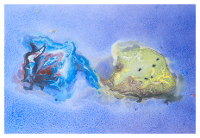Speaker
Dmitry Kotov
(SPbSPU)
Description
The flexibility of RHIC to collide different nuclei provides experiments with a rich set of data to systematically test models and scaling behaviors in various collision systems. In 2012 RHIC collided Cu+Au nuclei. These collisions promise an array of unique initial geometrical configurations. Such geometries present an opportunity to measure the wide range of initial energy densities of this system. They also allow the study of some unique features arising from these configurations. In particular, the odd harmonics from the Cu+Au system offer sensitivity to v3 generated from the collision geometry as opposed to fluctuations in a symmetric system.
The results from the global particle production and the challenges in analyzing this asymmetric system will be presented in the talk: spectra as a function of centrality, nuclear modification factors RAA and particle ratios such as proton/pion, and antiproton/proton will also be shown. The comparison with other colliding systems such as Au+Au will be carried out.
Author
Dmitry Kotov
(SPbSPU)
Co-authors
Alexei Safonov
(SPbSPU)
Mr
Dmitry Ivanishchev
(B.P. Konstantinov Petersburg Nuclear Physics Institute - PNPI)
Viktor Riabov
(B.P. Konstantinov Petersburg Nuclear Physics Institute - PNPI ()
Vladimir Samsonov
(B.P. Konstantinov Petersburg Nuclear Physics Institute - PNPI ()
Yaroslav Berdnikov
(SPbSPU)
Yuriy.G Ryabov
(B.P. Konstantinov Petersburg Nuclear Physics Institute - PNPI ()
